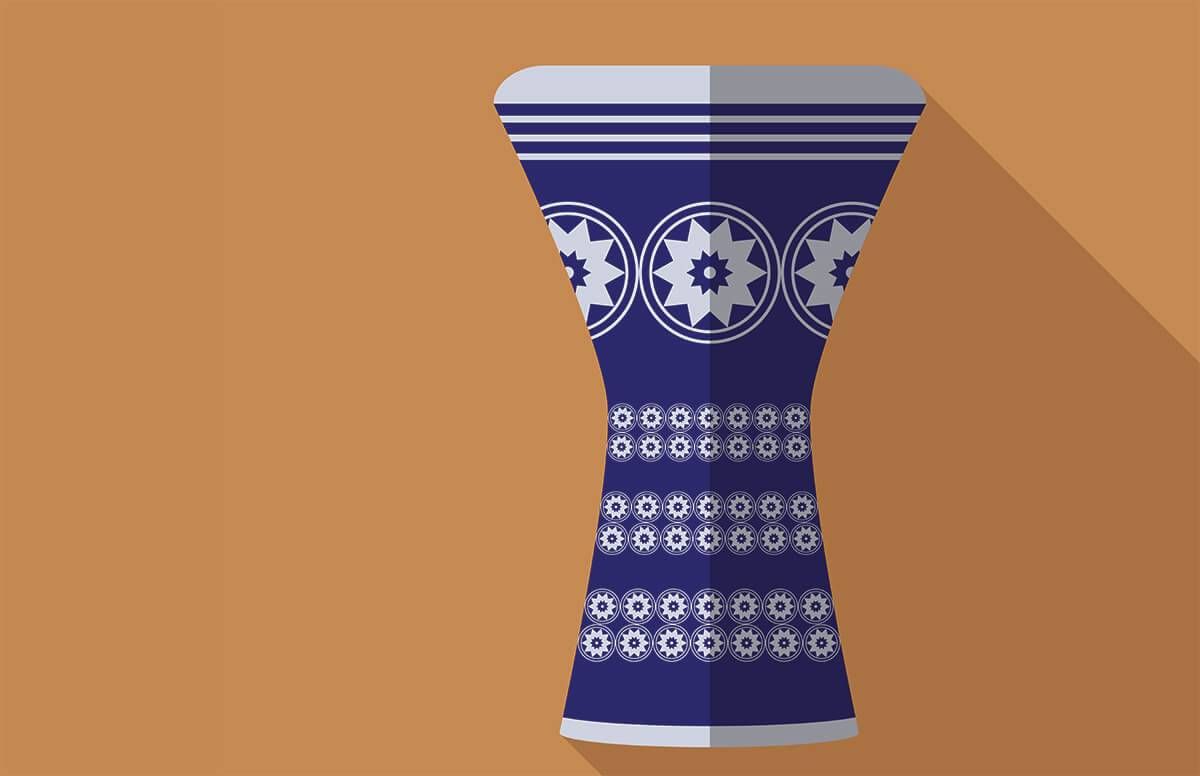Following the Beat of a Different Drummer
Learning a new hobby with an assist from football great Eli Manning
This is a story about a girl and her doumbek.

It started with a trip to Manhattan to see the acclaimed Broadway musical The Band’s Visit. As my husband and I left the theater after the final curtain, Bob talking enthusiastically about the bittersweet almost-love story and poignant performances, I realized that I’d been too distracted to fully appreciate what he had found most riveting.
Instead, my attention had been captured by the rapid-fire finger stylings of Ossama Farouk, an on-stage musician who was playing a hand-held goblet drum. Every time that guy’s fingers moved, I’d edged forward in my seat, trying to see what he was doing to produce such amazing sounds.
A few weeks later when Bob’s and my wedding anniversary rolled around, two packages awaited me on the kitchen table, one very small, one very large. Unwrapping the small one first, I found myself holding a DVD case with the words “Doumbek Technique & Rhythms” printed on the cover. Though I didn’t recognize the word Doumbek, I recognized the drum in the accompanying photograph.
“Oh, my God!” I cried, grabbing for the large box. “You didn’t!”
Yep, he did. I unboxed the instrument and stared in awe at this thing of black and white beauty that measured 11 inches across and stood a majestic 17 inches tall. A doumbek. My doumbek. I was in love.
Ready for a Doumbek Lesson
I was also more than a little intimidated. I have no natural drumming talent whatsoever. While I instinctively sway and tap my foot to strong beats, I’ve never been a finger tapper. Never been one to drum my fingers on tabletops. Never spent hours banging on bongos. I’ve never so much as held a pair of drumsticks, let alone sat behind a drum set and slashed away at the assorted drumheads and cymbals. At age 62, I was a drum virgin.
That afternoon, I turned on the DVD player, lined up the first lesson, and, taking my cue from the instructor, tucked the doumbek under my left arm. Quickly, I learned there were four basic sounds: doum, tek, ka and slap.
Doum was a piece of cake. Just a flat-out pounding of the right hand in the middle of the drumhead.
Tek involved a tap of the right-hand third finger. Not a problem.
Slap, a variation on doum, was a little tricky, but manageable.
Then, there was ka: a flick of the left-hand ring finger. The charming instructor warned that this motion would take a little getting used to. He lied. It takes a lot of getting used to.
Even so, I silently vowed to practice daily for a month before deciding whether I would persist or bail.
Feeling Hopeless About Improving at Drumming
Thus began my uneasy romance with my doumbek. Each day around 5:30 p.m., I queued up the DVD and played along with the instructor for 20 to 30 minutes, clumsily making my way through the sequence of Mideastern rhythms. Each day, the ring finger on my left hand ached as I restored the doumbek to its resting place in a corner of our living room. Each day, I could hear how dreadful my playing was. Truly. Terrible.
My husband, brave man, insisted that I was improving. But, then, what’s one rung up from dreadful? God-awful?
About two weeks on, my 23-year-old daughter dropped by for a visit. “Hey, cool,” she said, picking up the doumbek. “What’s this?”
As I told her what it was and how it had come into my life, her fingers tapped on the drumhead. By the time I finished my brief explanation, she was already a better drummer than I was. Seriously. Her left ring finger is way stronger than mine.
Hopeless, I thought, as I returned the doumbek to its corner. Hopeless, I thought the next day, as I dragged it out to practice.
A Surprising Source of Inspiration
A few days later I awoke to Super Bowl Sunday. The only football game I watch in any given year, I don’t tune in for the action on the field. I tune in for the commercials. Eagerly, I waited (in vain, it turned out) for the Clydesdales. Then an NFL commercial featuring quarterback Eli Manning lit up the screen, and those horses went right out of my head.
If you haven’t already seen it, stop reading immediately and click here.
Enchanting, right? But certainly not in the same way as Ossama Farouk’s dazzling finger work. What, I wondered, was so mesmerizing about this commercial? I hit the reverse button on my TV remote and played it again.
Sure, it was a giggle to see the improbable reenactment of the final dance scene in Dirty Dancing. And sure, it was delicious to see Manning and wide receiver Odell Beckham, Jr. twirl each other around the football field, then launch into the iconic lift made famous by Patrick Swayze and Jennifer Grey.
But upon further viewing (like, um, maybe eight times), I realized what really entranced me was Manning’s performance. His dancing was dreadful. Truly. Terrible. Yet he didn’t let that keep him from throwing himself into the dance moves with uninhibited conviction.
He showed no trace of embarrassment. No trace of self-consciousness that millions of people were going to see him dance so awkwardly. No trace of concern that he, the great Eli Manning, revered for his grace on the football field, was going to imprint himself as a klutz on viewers’ minds.
Instead, Manning telegraphed only one thing: his total commitment to the moment. Never mind that he was giving his everything to an activity for which he was hopelessly unsuited. Ungraceful though he might be, Manning was having, so to speak, the time of his life.
And that made his performance an enchanting one. An instructive one, too.
Playing with Abandon
I now try to approach my doumbek practice sessions with that same sort of outcome-be-damned attitude.
Yeah, my drumming is terrible, and unless I wake up with someone else’s fourth finger on my left hand, it will continue to be terrible.
But, hey, so what? I’ve never entertained a fantasy that I’ll someday play like Ossama Farouk. I do, however, now harbor a fantasy that, though quieter, in some ways feels grander: one day while torturing my poor doumbek, I’ll discover that I’m playing with the child-like abandon of Eli Manning.


